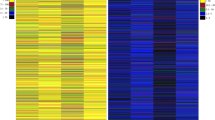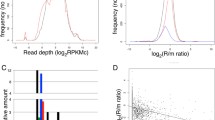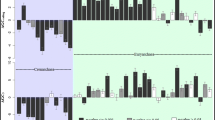Abstract
It is generally believed that the effect of translational selection on codon usage bias is related to the number of transfer RNA genes in bacteria, which is more with respect to the high expression genes than the whole genome. Keeping this in the background, we analyzed codon usage bias with respect to asparagine, isoleucine, phenylalanine, and tyrosine amino acids. Analysis was done in seventeen bacteria with the available gene expression data and information about the tRNA gene number. In most of the bacteria, it was observed that codon usage bias and tRNA gene number were not in agreement, which was unexpected. We extended the study further to 199 bacteria, limiting to the codon usage bias in the two highly expressed genes rpoB and rpoC which encode the RNA polymerase subunits β and β′, respectively. In concordance with the result in the high expression genes, codon usage bias in rpoB and rpoC genes was also found to not be in agreement with tRNA gene number in many of these bacteria. Our study indicates that tRNA gene numbers may not be the sole determining factor for translational selection of codon usage bias in bacterial genomes.

Similar content being viewed by others
References
Arnold HH, Keith G (1977) The nucleotide sequence of phenylalanine tRNA from Bacillus subtilis. Nucl Acids Res 4:2821–2829
Bossi L, Roth JR (1980) The influence of codon context on genetic code translation. Nature 286:123–127
Bulmer M (1987) Coevolution of codon usage and tRNA abundance. Nature 325:728–730
Bulmer M (1991) The selection–mutation–drift theory of synonymous codon usage. Genetics 129:897–907
Chen SL, Lee W, Hottes AK, Shapiro L, McAdams HH (2004) Codon usage between genomes is constrained by genome wide mutational processes. Proc Natl Acad Sci USA 101:3480–3485
Dong H, Nilsson L, Kurland CG (1996) Co-variation of tRNA abundance and codon usage in Escherichia coli at different growth rates. J Mol Biol 260:649–663
dos Reis M, Wernisch L (2009) Estimating translational selection in eukaryotic genomes. Mol Biol Evol 26:451–461
Duret L (2000) tRNA gene number and codon usage in the C. elegans genome are co-adapted for optimal translation of highly expressed genes. Trends Genet 16:287–289
Ermolaeva MD (2001) Synonymous codon usage in bacteria. Curr Issues Mol Biol 3:91–97
Fedorov A, Saxonov S, Gilbert W (2002) Regularities of context-dependent codon bias in eukaryotic genes. Nucl Acids Res 30:1192–1197
Francino MP, Ochman H (1997) Strand asymmetries in DNA evolution. Trends Genet 13:240–245
Gelfand MS, Koonin EV (1997) Avoidance of palindromic words in bacterial and archaeal genomes: a close connection with restriction enzymes. Nucl Acids Res 25:2430–2439
Gouy M (1987) Codon contexts in enterobacterial and coliphage genes. Mol Biol Evol 4:426–444
Gouy M, Gautier C (1982) Codon usage in bacteria: correlation with gene expressivity. Nucl Acids Res 10:7055–7074
Grosjean H, Fiers W (1982) Preferential codon usage in prokaryotic genes: the optimal codon-anticodon interaction energy and the selective codon usage in efficiently expressed genes. Gene 18:199–209
Harada F, Nishimura S (1972) Possible anticodon sequences of tRNAhis, tRNAasn, and tRNAasp from Escherichia coli B. Universal presence of nucleoside Q in the first position of the anticodon of these transfer ribonucleic acids. Biochemistry 11:301–308
Hershberg R, Petrov DA (2009) General rules for optimal codon choice. PLoS Genet 5:e1000556
Hershberg R, Petrov DA (2010) Evidence that mutation is universally biased towards AT in bacteria. PLoS Genet 6:e1001115
Higgs PG, Ran W (2008) Coevolution of codon usage and tRNA genes leads to alternative stable states of biased codon usage. Mol Biol Evol 25:2279–2291
Hildebrand F, Meyer A, Eyre-Walker A (2010) Evidence of selection upon genomic GC-content in bacteria. PLoS Genet 6:e1001107
Ikemura T (1981) Correlation between the abundance of Escherichia coli transfer RNAs and the occurrence of the respective codons in its protein genes, a proposal for a synonymous codon choice that is optimal for the E. coli translational system. J Mol Biol 151:389–409
Ikemura T (1985) Codon usage and tRNA content in unicellular and multicellular organisms. Mol Biol Evol 2:13–34
Ishihama Y, Schmidt T, Rappsilber J, Mann M, Hartl FU, Kerner MJ, Frishman D (2008) Protein abundance profiling of the Escherichia coli cytosol. BMC Genomics 9:102
Kanaya S, Yamada Y, Kudo Y, Ikemura T (1999) Studies of codon usage and tRNA genes of 18 unicellular organisms and quantification of Bacillus subtilis tRNAs: gene expression level and species specific diversity of codon usage based on multivariate analysis. Gene 238:143–155
Karlin S, Campbell AM, Mrázek J (1998) Comparative DNA analysis across diverse genomes. Annu Rev Genet 32:185–225
Lowe TM, Eddy SR (1997) tRNAscan-SE: a program for improved detection of transfer RNA genes in genome sequences. Nucl Acid Res 25:955–964
Muto A, Osawa S (1987) The guanine and cytosine content of genomic DNA and bacterial evolution. Proc Natl Acad Sci USA 84:166–169
Osawa S, Jukes TH, Watanabe K, Muto A (1992) Recent evidence for evolution of the genetic code. Microbiol Rev 56:229–264
Percudani R, Pavesi A, Ottonello S (1997) Transfer RNA gene redundancy and translational selection in Saccharomyces cerevisiae. J Mol Biol 268:322–330
Ran W, Higgs PG (2010) The influence of anticodon–codon interactions and modified bases on codon usage bias in bacteria. Mol Biol Evol 27:2129–2140
Rocha EPC (2004) Codon usage bias from tRNA’s point of view, redundancy, specialization, and efficient decoding for translation optimization. Genome Res 14:2279–2286
Rocha EPC, Feil EJ (2010) Mutational patterns cannot explain genome composition: are there any neutral sites in the genomes of bacteria? PLoS Genet 6:e1001104
Salser W (1969) The influence of the reading context upon the suppression of nonsense codons. Mol Gen Genet 105:125–130
Sharp PM, Li WH (1986a) An evolutionary perspective on synonymous codon usage in unicellular organisms. J Mol Evol 24:28–38
Sharp PM, Li WH (1986b) Codon usage in regulatory genes in Escherichia coli does not reflect selection for “rare” codons. Nucl Acids Res 14:7737–7749
Sharp PM, Bailes E, Grocock RJ, Peden JF, Sockett RE (2005) Variation in the strength of selected codon usage bias among bacteria. Nucl Acids Res 33:1141–1153
Shpaer EG (1986) Constraints on codon context in Escherichia coli genes. Their possible role in modulating the efficiency of translation. J Mol Biol 188:555–564
Acknowledgments
We thank Dr. Supek, the Rudjer Boskovic Institute, Croatia, for providing information for retrieving transcriptome data from the NCBI. We extend our thanks to Mrs. Madhusmita Dash, Qr. No. C-83, Tezpur University, for writing the C program for rank calculation. We also thank Dr. B.R. Powdel, Darang College, Tezpur, for his comments on the manuscript. We thank the two anonymous reviewers for their helpful comments on the previous version of this manuscript.
Author information
Authors and Affiliations
Corresponding author
Electronic supplementary material
Below is the link to the electronic supplementary material.
Rights and permissions
About this article
Cite this article
Satapathy, S.S., Dutta, M., Buragohain, A.K. et al. Transfer RNA Gene Numbers may not be Completely Responsible for the Codon Usage Bias in Asparagine, Isoleucine, Phenylalanine, and Tyrosine in the High Expression Genes in Bacteria. J Mol Evol 75, 34–42 (2012). https://doi.org/10.1007/s00239-012-9524-1
Received:
Accepted:
Published:
Issue Date:
DOI: https://doi.org/10.1007/s00239-012-9524-1




